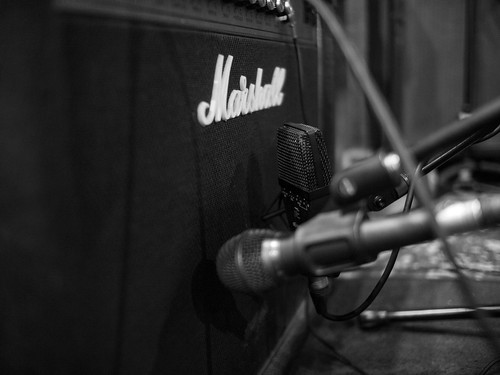You might assume that a 4×12 cabinet is significantly louder than a 2×12, but this isn’t always the case. While these cabinets do often offer more wattage, this is split between more speakers. The differences between these cabinets has more to do with your low-end response and overall presence than it does with pure power.
Still on the fence about which one’s right for you? We’ll break it down in more detail below, then you’ll find out which you should choose: 2×12 or 4×12 cabs.
2×12 or 4×12 Cabs: 2×12 Cabinets
For many guitarists, a 2×12 cabinet is the ideal size. It has more power than a 1X12 without being too heavy to carry to gigs. They’re also often rated at a wattage that takes full advantage of the power provided by most amp heads.
One advantage of the 2×12 cabinet is that it offers you more versatility. You can get two 2×12 cabs and stack them for gigs at larger venues, or pare your set-up down to one for practices and smaller clubs. This will cost you more than buying a single 4×12 but a lot of players find that a decent trade off for the easier transportation.
Orange PPC212 2×12 Cabinet Celestion V30
Orange makes some of the best amps and cabinets on the market, and has been at the top of the game for decades. This closed-back cabinet produces 120 watts of power, which it pours into two Celestion Vintage 30 speakers. The total effect gives you a punchy sound with a natural reverb.
The PPC212 (see full specs) is the ideal 2×12” cab to look at in comparison to 4×12” models because it was based on the PPC412. It’s wider than many 2×12”, giving it a larger interior volume for a fat tone more similar to what you’d get from more speakers. The flip side of this is that it loses some of the 2×12” portability—at almost 80 pounds, it’s not exactly portable.
An Orange head is obviously a great pairing for this cabinet, but it’ll bring that same natural depth to any valve head that can give it enough power. It’s built of durable 18mm Birch so it’s road-ready and will serve you well for years on the road.
Marshall Amps MXR 2×12 Cab
If you’re looking for a 2×12 cabinet that’s a bit more affordable, the MXR from Marshall gives you just as much power as the Orange above. It uses a pair of Celestion 70/80 speakers that are designed to give you that classic British sound when paired with any Marshall head.
This Marshall amp is probably more the size you think of when you picture a 2×12. It’s a manageable load at just under 50 pounds. One unique feature of this amp is that it’s available in either a horizontal or a vertical configuration. This gives you more options when it comes to arranging your equipment.
From the black grille to the vintage sound, everything about this Marshall cabinet is classic. Best of all, you’ll love the sound. It’s thick through the mid-range with a musical high-end that’s never thin or jangly.
2×12 or 4×12 Cabs: 4×12 Cabinets
The 4×12 is a beast of a cabinet—the largest cabinet you’re likely to see, aside from the rare sighting of a 4X15. The disadvantages are obvious: they’re heavy and difficult to transport. So why would you want to get a 4×12?
A 4×12 cab is the most economical way to get more sound. You’ll pay less per speaker with a 4×12 than two 2x12s. The larger cabinet also gives the soundwaves more room to resonate, translating to a fuller sound with a better bass response.
Marshall 1960B 4×12 Cabinet
Marshall makes excellent cabinets in a variety of sizes. This 1960B 4×12 cabinet is available in both straight and angled versions. It gives you a variety of impedance options, too, which makes it easier to match with other equipment.
Players who want maximum sonic output from a single amp will love the Marshall 1960B (see full specs). The closed-back design enhances the low end and presence. The four Celestion G12T-75 speakers get 300 watts of power, for big, beautiful sound on both clean settings and high gain.
You’ll want to get a pretty powerful head to go with this impressive cabinet, but in truth it has the power to make just about any head sound fantastic. The biggest problem you’ll have with this cabinet is moving it to gigs. It does weigh nearly 100 pounds, though the wheels on the bottom do help with the mobility.
Peavey 6505 4×12 Slant Cabinet
Not all 4×12 cabinets are priced to break the bank. You can find pretty decent models for a reasonable price, including this Peavey 6505. Its stats have a lot in common with the Marshall above—an angled, closed-back cabinet with 300 watts of power. It gives one of the lowest per-speaker costs you’ll find in an amp.
The materials used in the Peavey 6505 are fairly basic. It has a plywood construction and is loaded with four Sheffield 1200 speakers. Don’t take this to mean the construction’s shoddy. This is a workhorse of a cabinet, with heavy-duty casters on the base to help with transportation.
Power-wise, this cabinet will blow you away. You’ll get enough volume to fill any club, even if you play louder, harder styles. The sound is a bit more modern than what you’ll find with many 4x12s, making it a top choice for metal and rock players.
2×12 or 4×12 Cabs: So Which Cabinet Size Do You Want?
There’s no wrong answer to this question. You’ll find pros backed by both these cab sizes, and in lots of combinations. Remember that it comes down to a question of presence more than it does pure volume. In many respects, 2×12 cabinets give you more versatility, and they’re definitely more practical for practice sessions and gigs at smaller venues. Whichever one you choose, the four cabinets on this list are all high-quality choices that will make any amp head sing. Good luck!








